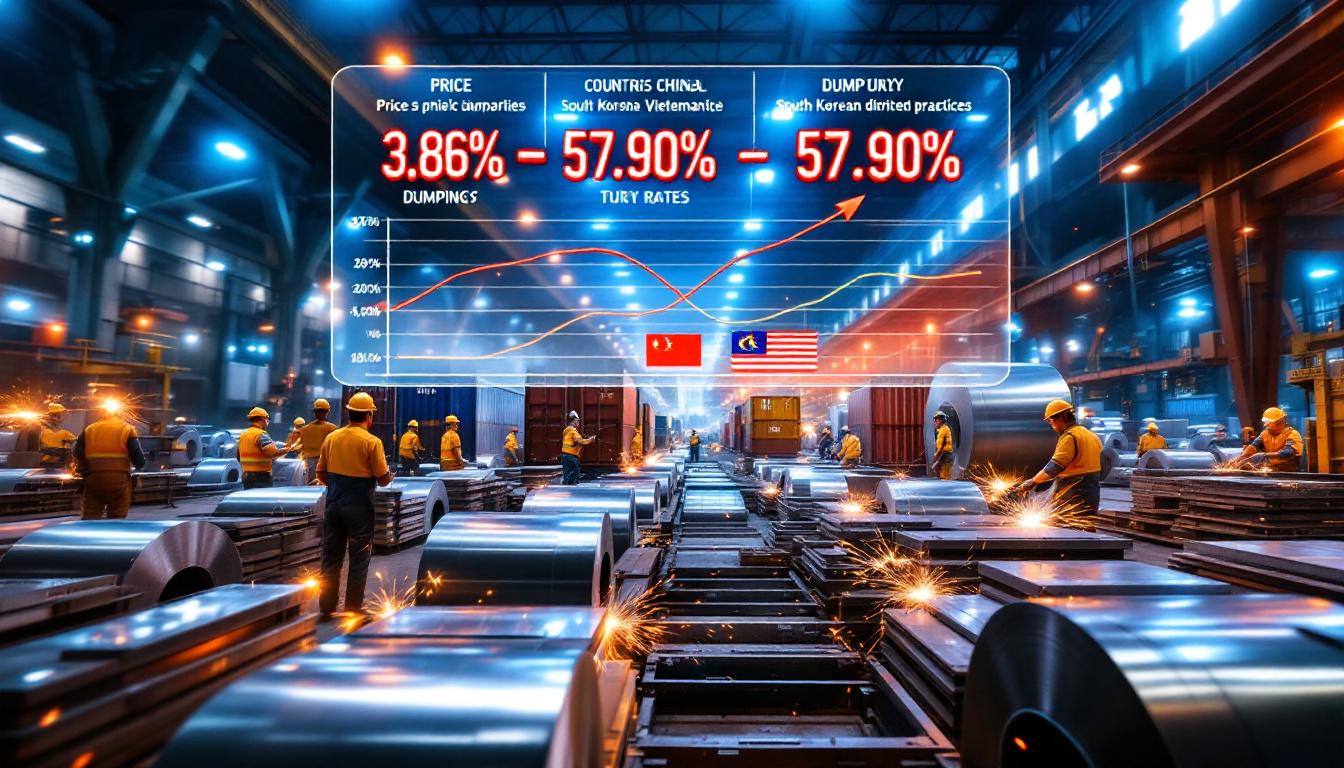What Are Tariffs and How Do They Impact Global Trade?
Definition and Basic Mechanics of Tariffs
Tariffs are taxes imposed by governments on imported goods entering a country. Originally designed as revenue-generating tools for governments, tariffs have evolved into powerful instruments of trade policy and economic protection. When a country implements tariffs, it directly increases the cost of foreign products to make domestic alternatives more competitive.
Types of tariffs vary in structure and application. Ad valorem tariffs apply a percentage to the value of imported goods (e.g., 25% on steel imports), while specific tariffs charge a fixed amount per unit (e.g., $0.25 per pound). Compound tariffs combine both approaches, and quota-based systems limit import quantities while applying higher rates to excess amounts.
The implementation process involves customs authorities classifying products according to harmonized tariff schedules, verifying country of origin, calculating applicable duties, and ensuring proper collection. While seemingly straightforward, the complexity of modern supply chains and international trade agreements creates significant administrative challenges.
The Stated Goals vs. Actual Outcomes of Tariff Policies
Proponents of tariffs cite several key objectives: protecting domestic industries from foreign competition, preserving jobs in strategic sectors, generating government revenue, reducing trade deficits, and safeguarding national security interests. However, empirical evidence reveals a significant gap between these stated goals and actual outcomes.
While tariffs may temporarily protect specific industries, they typically trigger broader economic consequences. For example, U.S. steel tariffs implemented in 2018 protected approximately 140,000 steel industry jobs but raised costs for the 6.5 million Americans working in steel-consuming industries, creating a net negative employment effect.
Trade deficit reduction, another common justification, rarely materializes as expected. The U.S.-China bilateral goods trade deficit actually grew by 21% in the two years following initial tariff implementation, contradicting predictions. This occurs because tariffs often shift trade patterns rather than fundamentally changing consumption habits or addressing structural economic imbalances.
"Tariffs are a tax on consumers and businesses that will continue to inflict harm on American businesses, farmers, workers and consumers as long as they remain in effect." – National Retail Federation
National security justifications for tariffs on critical materials and technologies present their own contradictions. While securing supply chains for sensitive products has merit, broad-based tariffs can alienate allies and fragment collaborative research efforts that might better address security concerns through cooperation rather than isolation.
How Do Trade Wars Develop and Escalate?
Anatomy of a Trade War
Trade wars typically begin with a triggering event—often a unilateral tariff imposed by one country citing unfair trade practices. The 2018 U.S.-China trade conflict exemplifies this pattern, starting with U.S. tariffs on washing machines and solar panels before expanding to aluminum, steel, and eventually hundreds of billions in goods.
The escalation follows a predictable pattern of retaliatory cycles. When Country A imposes tariffs, Country B responds with counter-tariffs, often carefully targeting politically sensitive industries. For instance, China's retaliatory tariffs strategically focused on U.S. agricultural products from states crucial to electoral politics, maximizing political pressure while minimizing domestic economic damage.
Sector targeting reveals the strategic calculation behind seemingly economic decisions. Countries select industries for maximum leverage—targeting areas with strong political constituencies, minimal domestic disruption, and significant symbolic value. This explains why agricultural products, luxury goods, and iconic brands (like Harley-Davidson motorcycles or Kentucky bourbon) feature prominently in trade conflicts.
Negotiation phases often follow a three-stage pattern: threats and posturing, partial implementation with exemptions, and eventual settlement attempts. The challenge in resolving trade wars lies in the asymmetric political costs of appearing to "back down" versus the symmetric economic costs of continuing restrictions.
Psychological and Diplomatic Dimensions
Trade wars erode trust in international systems, undermining decades-built cooperation frameworks. The WTO dispute resolution mechanism, designed to manage trade conflicts through rules-based processes, loses effectiveness when major powers circumvent established channels in favor of bilateral confrontation.
The perception management aspects reveal how differently tariffs and trade wars are framed domestically versus internationally. Leaders typically present tariffs to domestic audiences as necessary defense against unfair foreign practices, while internationally projecting willingness to negotiate. This dual messaging creates significant communication challenges and mistrust.
Alliance strains become inevitable as trade conflicts spill into security relationships. The U.S.-EU tensions over steel and aluminum tariffs strained NATO cooperation, while Pacific trade frictions complicated security coordination against common challenges in Asia.
Trade wars also amplify nationalistic narratives, reframing economic policy disputes as matters of sovereignty and national pride. This transformation from technical trade disagreement to perceived national humiliation significantly raises the political stakes of compromise.
What Are the Economic Consequences of Trade Wars?
Short-Term Market Disruptions
The immediate effects of trade wars appear in disrupted supply chains, as companies scramble to secure inventory ahead of tariff implementation dates. During the 2018-2019 period, U.S. imports from China surged temporarily before tariffs took effect, creating warehouse capacity shortages and logistical bottlenecks at major ports.
Price inflation follows as companies pass tariff costs to consumers. Research from the Federal Reserve and Princeton University found that American consumers bore nearly the entire burden of U.S. tariffs, with approximately 10-25% of tariff costs directly reflected in higher retail prices. For example, washing machine prices increased by an average of $86 per unit following tariff implementation.
Sector-specific impacts vary dramatically based on supply chain integration and substitution possibilities. The American agricultural sector saw exports to China fall by over 50% in 2018, requiring $28 billion in emergency subsidies to affected farmers. Meanwhile, technology companies faced disrupted component sourcing and manufacturing relocations that delayed product development cycles.
Employment shifts create complex mixed effects across regions and industries. While some protected sectors see job gains (estimated at 126,900 in metal-producing industries), export-dependent and downstream manufacturing sectors experience greater losses (estimated at 175,000 positions). These asymmetric effects concentrate benefits narrowly while distributing costs broadly across the economy.
Long-Term Structural Changes
The enduring impact of trade wars appears in permanent changes to global business strategies and supply chains. After experiencing tariff-induced disruptions, companies implement "China plus one" or regional diversification strategies, redistributing production facilities across multiple countries to reduce dependence on any single market.
Manufacturing reshoring faces significant challenges beyond tariff incentives. The U.S. manufacturing skills gap—with an estimated 2.4 million unfilled positions projected by 2028—highlights how decades of offshoring created structural workforce limitations that tariffs alone cannot resolve. Infrastructure limitations, from outdated transportation networks to insufficient supplier ecosystems, further constrain domestic production revitalization.
Market access losses often become permanent as global buyers establish new supplier relationships. For example, Brazilian soybean farmers captured Chinese market share during U.S.-China tensions, investing in expanded production capacity that will continue competing with American exports even after tariff resolution.
Innovation suffers from reduced knowledge flows and market fragmentation. Research collaboration between U.S. and Chinese institutions fell by 20% during escalating trade tensions, while technology companies faced new constraints on global talent recruitment. These barriers to knowledge diffusion potentially slow breakthrough developments in critical fields like artificial intelligence, renewable energy, and biotechnology.
Economic growth reductions emerge from these combined effects. International Monetary Fund analysis estimates that continued trade tensions could reduce global commodities insights by 0.8% by 2025, with particular vulnerability in export-oriented economies and emerging markets dependent on global supply chain participation.
How Do Tariffs Affect Different Economic Systems?
Impact on Export-Oriented Economies
Export-dependent economies like South Korea, Germany, and Taiwan face unique vulnerabilities to tariff escalation. These manufacturing hubs, which derive 25-50% of their GDP from exports, experience amplified effects from global trade disruptions regardless of whether they're directly targeted.
A country's position in global value chains significantly influences tariff impacts. Economies specializing in intermediate components (like Malaysia in electronics or Thailand in automotive parts) face double exposure—both directly through tariffs on their exports and indirectly through reduced demand when final product exports decline.
Adaptation strategies typically include market diversification efforts and domestic consumption promotion. South Korea's "New Southern Policy" accelerated engagement with Southeast Asian markets to reduce dependence on China and the U.S., while Taiwan's reshoring incentives attracted $33 billion in manufacturing investment returns between 2019-2021.
Currency management emerges as a key tool for export economies facing tariff headwinds. When South Korea's won depreciated 5% against the dollar during 2018 trade tensions, it partially offset U.S. tariff effects by making Korean exports more price competitive. This competitive devaluation temptation creates additional tensions in the international monetary system.
Effects on Consumer-Driven Economies
In consumption-oriented economies like the United States, tariffs produce complex ripple effects throughout domestic markets. Consumer price increases on imported goods directly reduce purchasing power, with studies showing U.S. households faced approximately $831 in additional annual costs from 2018-2019 tariffs—effectively a regressive tax that disproportionately affects lower-income consumers.
Domestic production incentives from tariff protection generate mixed results. While some manufacturing sectors saw increased investment and capacity expansion (U.S. steel utilization rose from 73% to 81% following section 232 tariffs), the higher input costs for downstream manufacturers often outweighed benefits, leading to net negative effects on industrial production.
Wage and employment dynamics reveal sectoral disparities. Protected industries experienced modest employment gains, but these were concentrated in specific regions and often offset by larger job losses in industries using tariffed inputs. For example, U.S. aluminum production jobs increased by approximately 300, while downstream industries employing over 97,000 workers faced higher costs and competitive disadvantages.
Inflation pressure from tariffs creates monetary policy challenges. Central banks must decide whether to treat tariff-induced price increases as one-time shocks or persistent inflationary pressures requiring interest rate responses—a dilemma that complicates already-delicate economic management during trade tensions.
What Makes China's Response to Tariffs Unique?
China's Structural Economic Challenges
China's economic model faces a fundamental imbalance between investment and consumption that tariffs exacerbate rather than resolve. With household consumption representing only 38% of GDP (compared to 68% in the U.S.), China relies heavily on investment-driven growth. Trade tensions reinforced this dependence, with Beijing launching ¥4.7 trillion ($677 billion) in infrastructure investment to offset export weakness rather than pivoting to consumption-led growth.
Policy responses to tariffs revealed leadership priorities. Rather than accelerating market reforms that might address underlying trade tensions, China doubled down on state-directed industrial policy, expanding subsidies for strategic sectors like semiconductors from $8 billion to over $30 billion annually between 2018-2020.
Currency management became a critical balancing act. The yuan's controlled depreciation against the dollar (falling from 6.3 to 7.1 yuan per dollar during peak tensions) helped offset tariff impacts on export competitiveness but raised capital flight concerns and international accusations of manipulation.
"China's response to trade tensions has not been to address the underlying structural issues that concern its trading partners, but rather to double down on the state-directed economic model while seeking alternative markets." – European Chamber of Commerce in China
Domestic economic reform delays represent perhaps the most significant long-term consequence. External pressure that might have catalyzed market-oriented reforms instead strengthened nationalist sentiments and security-focused economic policies, potentially delaying China's transition to a more sustainable growth model.
Strategic Adaptation to Reduced US Market Access
China's market diversification strategy accelerated dramatically during trade tensions. The Belt and Road Initiative expanded from 65 to 140 participating countries between 2017-2021, channeling over $59 billion in annual Chinese investment to develop alternative export markets and secure resource supplies.
Self-sufficiency drives intensified across strategic sectors. The "Made in China 2025" initiative received expanded funding and political emphasis, particularly in semiconductor production, where investments exceeded $150 billion as China sought to reduce dependence on U.S. technology. Though progress remains uneven, domestic chip production increased from covering 16% to 30% of China's needs between 2018-2022.
Agricultural sourcing underwent dramatic realignment. Chinese imports of Brazilian soybeans increased 30% year-over-year following U.S. tariffs, while new agricultural trade agreements with Russia, Argentina, and Ukraine reduced dependence on American farmers. These new supplier relationships, once established, have proven difficult for U.S. exporters to recapture even after partial tariff rollbacks.
Long-term planning separates China's response from many counterparts. Rather than focusing primarily on immediate retaliation, Chinese policy emphasizes "strategic patience" through multi-decade resilience strategies. This includes developing technological independence in critical sectors, reducing dollar dependence in trade settlement, and building parallel international institutions like the Asian Infrastructure Investment Bank.
Why Does America's Trade Position Create Unique Vulnerabilities?
The Dollar Dominance Paradox
America's trade position creates a fundamental paradox related to dollar dominance. As the world's reserve currency, dollars must continuously flow outward through U.S. trade deficits to supply global liquidity needs. This "exorbitant privilege" allows America to finance consumption through foreign lending, but creates tension when trade policies attempt to eliminate those same deficits.
Financial power projection through dollar access has become a primary geopolitical tool. Between 2018-2022, U.S. sanctions increased by 933%, restricting dollar access for targeted nations and entities. This weaponization of financial infrastructure accelerated development of alternative payment systems that may eventually undermine dollar primacy.
Liquidity challenges emerge when trade tensions disrupt dollar circulation. The March 2020 dollar funding crisis—when COVID-19 fears and trade uncertainties triggered global institutional scrambles for dollar liquidity—demonstrated how quickly cross-border tensions can create financial system stress, requiring massive Federal Reserve swap lines to prevent systemic collapse.
Trust erosion in dollar infrastructure represents a gradual but significant consequence. Central banks diversified reserves away from dollars, with the greenback's share of global reserves declining from 65% to 59% between 2016-2022. Gold accumulation by Russia, China, Turkey, and others accelerated, with central banks adding over 1,136 tons of gold between 2018-2022—the highest five-year purchase total since 1967.
Manufacturing Capacity Erosion
America's manufacturing capacity faces structural challenges that tariffs alone cannot address. The skills gap reality presents perhaps the most significant barrier—with an estimated 2.4 million manufacturing positions potentially unfilled through 2028 due to workforce retirements and insufficient technical training pipelines.
Infrastructure limitations compound workforce challenges. After decades of offshoring, the U.S. industrial supply base has hollowed out, with critical components and materials now sourced predominantly from overseas. Rebuilding these complex industrial ecosystems requires more than tariff incentives—it demands coordinated public-private investment in physical infrastructure, supplier networks, and technical education.
Capital equipment deficits highlight the chicken-and-egg problem of reshoring. Many specialized manufacturing tools and machines are themselves no longer produced domestically, creating dependence on foreign equipment to rebuild domestic production capacity. For example, the U.S. machine tool industry declined from global leadership to approximately 5% market share over four decades.
Workforce training requires generational timeframes rather than electoral cycles. Developing specialized manufacturing skills—from tool and die making to advanced materials processing—typically requires 3-5 years of technical education and apprenticeship, creating political challenges when benefits materialize beyond typical political timeframes.
Competitive disadvantages extend beyond labor costs to include regulatory compliance, energy prices, and tax structures. While Trump's commodity policies can temporarily level price differentials, they cannot address underlying structural factors that influence production location decisions across global value chains.
How Are Global Financial Systems Affected by Trade Tensions?
Liquidity and Trust Challenges
Trade tensions expose structural vulnerabilities in global financial systems, particularly around dollar liquidity management. Federal Reserve influence faces growing limitations beyond short-term rate adjustments, as politicization of dollar access pushes international actors toward alternative arrangements. During 2019-2020 market stress, overnight repo rates spiked to 10% despite Fed target rates below 2%, revealing fragilities in core funding markets.
Debt sustainability concerns intensify when trade restrictions undermine growth assumptions. U.S. national debt management becomes more challenging in a fragmented system where foreign appetite for Treasury securities may wane. Foreign holdings of U.S. debt declined from 50% to 33% between 2008-2022, reflecting both diversification efforts and liquidity needs.
Dollar funding stresses particularly affect European banks with significant dollar-denominated business but limited direct access to Federal Reserve facilities. During periods of trade tension, the cross-currency basis swap spread (effectively the premium paid to obtain dollars through currency swaps) widened significantly, indicating stress in dollar acquisition markets.
Asset liquidation patterns reveal how market dynamics on good news can be overwhelmed during trade tensions, triggering cascading financial pressures. China's Treasury sales, which accelerated during peak trade conflicts, reflected both strategic signaling and genuine liquidity needs as capital outflows increased. These sales, while modest relative to total holdings, created market volatility that affected global debt pricing.
Financial crisis warning signs increasingly appear in liquidity preference and collateral shortages. The growing demand for high-quality liquid assets amid trade uncertainty restricts the lubricant necessary for efficient market functioning, potentially amplifying future shocks rather than absorbing them.
Alternative Financial Architecture Development
De-dollarization efforts have accelerated beyond rhetoric to concrete institutional development.
Ready to Act Fast When the Next Major Mineral Discovery Hits the Market?
Discovery Alert's proprietary Discovery IQ model provides immediate, real-time notifications of significant ASX mineral discoveries, delivering actionable investment insights before the broader market reacts. Visit our discoveries page to explore how historic mineral discoveries have generated substantial returns and begin your 30-day free trial today.




